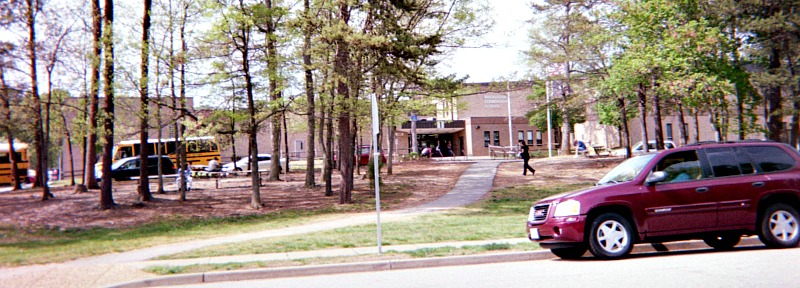Teacher lesson plans should include the use of mobile phones
Teacher lesson plans should include using mobile phone devices. This is an educational innovation. Although there are pros and cons to the use of mobile phones in school, a new study supports the idea that kids use mobile phones to learn new things. However, the study also notes that most schools are not realizing the benefits of student use of mobile phones in the classroom.
 You can't see them now. The kids are in their classrooms using their mobile phones to help them with their history lessons.
You can't see them now. The kids are in their classrooms using their mobile phones to help them with their history lessons.Verizon Foundation commissioned TRU to conduct quantitative research on middle school students using technology and mobile phones in classrooms. TRU conducted 1,000 online interviews among sixth-to-eighth grade students, ages 11 to 14 living in the United States.
The research conducted by the study demonstrates that mobile technology can inspire and engage student learning in the classroom. Students can choose which devices they know, prefer and enjoy using to complement the education they are receiving in school. In spite of the rules schools establishes the use of mobile phones, students often will disregard these rules. On their own, they take the initiative to use mobile phones to enhance their educational experience in school.
How technology improves learning instruction
Despite the perception of some parents and teachers who use mobile phones, they are used to access online education games for kids including reading games for kids. Mobile phones also help them learn the problem solving skills that math for kids teaches. Middle school students experience increased educational motivation and confidence while using mobile phone technology to learn new concepts. This contradicts the school policy in 88 percent of today's schools that strictly prohibits the use of mobile phones to enhance the quality of traditional classroom education. The results of this survey should be an encouragement to teachers to include mobile phones and mobile phone apps in their daily teacher lesson plans.
Incorporating the use of mobile phone apps in teacher lesson plans is fun
There are six ways that mobile phones can help children learn in school or after school at home. In addition to providing online education games for kids, mobile phones can also function effectively as teaching tools. These tools can be incorporated into teacher lesson plans, research important facts, help kids look up, or teach kids reading in fun way through reading games for kids.
• Apps or application programs for mobile phones help to make learning subjects easier. Some apps help kids with math homework assignments.
• Students have their own portable research tool available anytime they need to find information on the Internet for a school assignment.
 Elementary school students could use their mobile phones to research on the Internet how colonial toys were made.
Elementary school students could use their mobile phones to research on the Internet how colonial toys were made.• Mobile phones helps students develop reading and comprehension skills.
• Brain exercising apps for mobile phones help kids increase their learning skills. Students retain what they have learned in school..
• Students who are comfortable using computer and mobile phone technology and out of the classroom will have a greater chance of having successful careers after they finish their education.
• Mobile phones facilitate teacher to student communication. Students can receive homework reminders, reading materials and other instructional aids from their teachers using mobile phone devices.
Why teachers should prepare lesson plans
Teacher lesson plans are needed for the instructional day. Some characteristics of a good teacher include the ability to develop a great lesson plan. Without an effective lesson plan in place of the educational day can be confusing leading to many classroom problems. Kids need lots of direction. Lesson plans provide stability, direction and a clear path to follow when teaching subject matter to elementary, middle and high school students. Lesson plans save the teacher time. The material in lesson plans can be used repeatedly for many years.
Writing lesson plans is one of the many roles of a teacher. A good lesson plan raises the confidence level of a teacher when conveying important knowledge to students. He or she will be more prepared to answer student questions after explaining complex ideas and concepts to them. A lesson plan is a basic how to deliver great information to students in ways that they will easily understand and grasp the concepts of the lesson. Students show more respect toward confident teachers. When teachers earn the respect and trust of their students, they will spend less time discipling them and more time teaching them subject matter in class.
What about the substitute teacher?
In a teacher's absence, the substitute teacher will have a road map to follow. The substitute will know what the teacher expects from her students for the day's instruction. The lesson plans will include readings, lesson activities and handouts or in class assignments. If the students are to be tested, the lesson plans will include instructions on how students should be tested and what tests or quizzes should be given to the students. The substitute will experience the different roles of a teacher by following great lesson plans.
Lesson plans help a teacher know what and how to teach. The same topic can and should be taught differently to match the learning ability of each student. Not all students learn alike. Lesson plans should be developed to reflect the diversity of each student in the classroom. Teacher lesson plans should be included in the list of teacher responsibilities. A lesson plan is important when it comes to following standards of learning. Lesson plans convey important information that students should know to pass SOL tests at the end of the year.
What's the purpose of a lesson plan?
Teacher lesson plans clarify the subject matter in a systematic approach to help students achieve their educational goals. When teachers have an effective method of teaching in place, students will become better learners. Teacher lesson plans help teachers make decisions about the teaching methods they will use in class.
Teachers won't have to think about their feet because they will have clearly written procedures to follow when teaching. It's hard enough to teach a group of unruly students, let alone stop and think about what to say. With a clear lesson plan in place, teachers can focus more on each lesson. They will keep the attention of their students much better when they are more prepared to teach in class.
What should a lesson plan include?
Teacher lesson plans should include the goals and objectives for each lesson. It should also include classroom and homework assignments. Free teaching workshops can be found on the Internet for inclusion with the lesson plans. Other lesson resources should be added to each lesson plan.
Direct instructions are ways teachers can effectively explain the material to students. Some students need more help and individual attention than other students. Direct instructions can guide the teacher how to guide these slower learners and help them keep up with the rest of the class. Lesson plans should also include ways to keep students motivated and interested in what they are studying in class.
Include instructions for the use of mobile phones
For phones class If mobile phones are not used then day, then instructions counting students to put away their mobile devices should be part of the lesson plans. If mobile phones are used for instructional activities, then add directions on how students should use their mobile phones in class for educational activities to the teacher lesson plans.
For more ideas on what to include in lesson plans, teachers can visit teachers' websites for teacher lesson plans. Do a google search for "what should be included" and you will find articles and resources on what to include when writing a lesson plan. Ideas for inclusion in a lesson plan are warm up, introduction, practice, production and review.
How can teachers improve teacher lesson plans?
Teachers can try to remember their own student days. What did they enjoy about the classes they took? Which were their favorite teachers in school? Why? What was easiest for them to learn? What subjects are the hardest for them to complete?
By asking questions like this, teachers can determine the best approaches when writing lesson plans for their own students. How can teachers include assignments in the lesson plans that will help students better understand the material explained in class? What teaching tools should be available to students?
What's important for students to know?
Teachers should plan the important information students should know to do on a test. Lessons should match the school expectations and standards of learning for each subject taught. Homework and in class assignments should match these expectations. These are relevant to the materials students are expected to master the well-being of tests, then teachers should include more relevant educational materials in each lesson plan.
Teacher lesson plans should include goals and objectives for each lesson. What are students expected to know? How can the teacher convey this information with easy-to-understand explanations? Include a way to explain complex subjects. Show how to solve difficult math problems. Explain grammar using sentence diagrams. Explain difficult science concepts using simple terms.
Don't forget to include teaching resources
Resources for each lesson should be included in the lesson plan. List the books and pages students should read. Include technology and other equipment that students will need to use to complete in-class and out-of-class assignments. Explore teachers' websites for learning resources to include in the lesson plans. There are first grade teacher websites, third grade teacher websites and other elementary teacher websites. Teachers can also teach teacher lesson plans for other ideas on what to do when writing about teaching lesson plan resources to use.
When planning out each day's lesson use teaching strategies that go beyond the textbook. Some ideas for other learning tools include posters, illustrations, pictures, the Internet, newspapers, brochures. Teachers could also use songs, television and comics.
 Mobile phones could be used to capture memories on student class trips like this camel at Mount Vernon, Virginia.
Mobile phones could be used to capture memories on student class trips like this camel at Mount Vernon, Virginia.Establishing learning objectives
The learning objective should not be too broad or too specific. It should be just like the solution Goldilocks found in the house of the three bears. Visual lessons should also be included in the lesson plans. Research shows that help raise student interest, while helping teachers include simple explanations. Examples of visual aids include pictures, videos, charts, maps, whiteboards, objects, models, bulletin boards, flashcards, graphic organizers, tablets and chalkboards.
Offer student choices in the lesson plans. List assignments on the board and be ready to ask students which assignment they would prefer to work on in class. The other assignments can be completed at home. Student choice is a great motivator in the educational process. Assignments should be planned for each lesson.
Create the planning assessment first. This is the best way to decide what students should know at the end of the lesson. Then the lesson can be created based on that information. The idea is to create a test based on teaching standards and curriculum. An effective lesson plan can be created based on this test. Planning the assessment is a good way to ensure that students are hitting their checkpoints and grasping each skill or concept taught in class.
How to create lessons students will love
In order to create transformational lessons, each lesson should center around the lives of students. Carefully crafted objectives so that they are not too broad or specific, but just right. Go beyond the textbook by including visuals and give the students the opportunity of choice. This results in transforming lessons that engage students and motivate them to master lessons they are expected to know. Watch student performance in class and test scores rise.
Here are some other ways to improve teacher lesson plans. Know the standards, core concepts, curriculum and strategies. Shift from solo to collaborative lesson design. Create presentations that show more than counting. Find ways to include introverted students in classroom discussions and encourage them to speak up and contribute more in class. Integrate productive struggle into the curriculum. In other words, do not lower the expectations of the next lesson plan.
Following these suggestions will ensure that lesson plans are complete. The instructional day will improve with careful thought out and prepared plans. Students will know exactly what the teacher expectations are for each day. This will lead to less discipline problems and student learning, motivation and performance will increase. Improving lesson plans can make a big difference in the instructional day.
How to incorporate the use of primary sources of historical information in your daily lesson plans.
Here is more information about about lesson planning.









